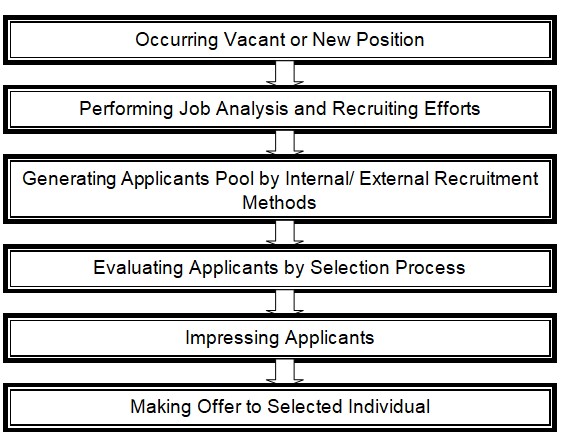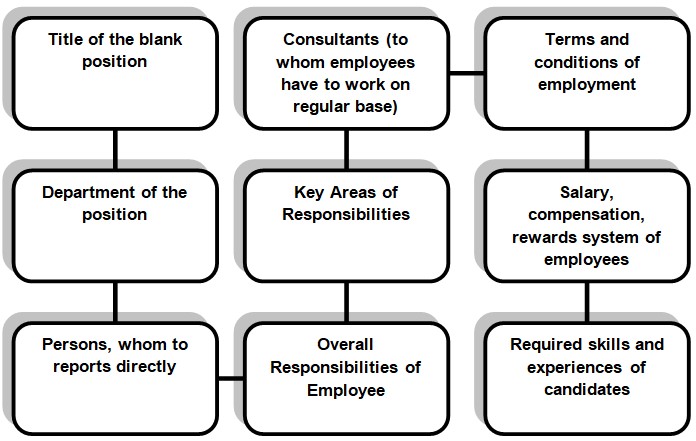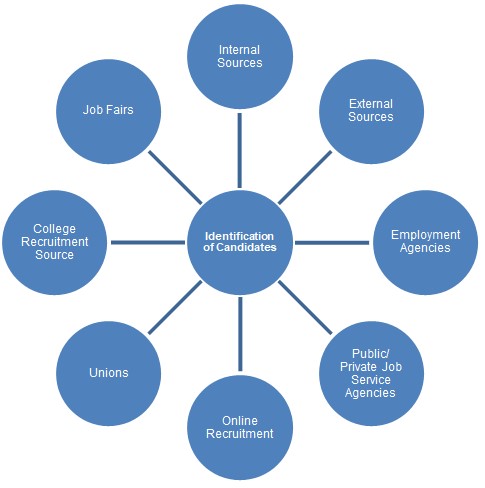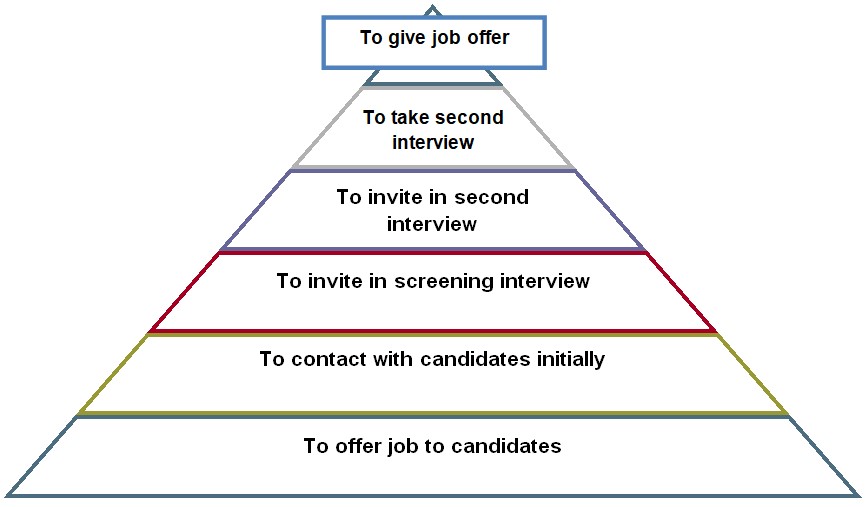Introduction
Organizational success is depending on acquisition and retention of talented human resources for specific position. In 21st century, the job markets are growing with competitive rates and availability of skilled recruiters are being large and selective, as the organization has to build up long term effects with them, like sky-scraping training, high turnover, employees’ morale, and overall the development costs of organization. More on, organization’s objectives are achieving with the help of its staffs. Thus, the recruitment process is more important for any organization. In this paper, if any employee of an organization is deciding to leave the job position for any specific reason, as personal or others, how organization can recruit a successor for that employee and how the process of recruitment would goes on, has described to specific candidates for the job position.
Recruitment Process of Job Position
According to Richardson (2009, p. 3), recruitment is set of activities and process by which the organization can locate and attract sufficient number of qualified people at the right job position in shortest possible time with long-term interests to fill vacancies. Every organization has needed continuous proper employment, which is an important part of HR planning and forecasting. The continuous need of employment can caused for many reasons, like replacement, leave, or promotion of employees and acquisition of new skills in the organization. Recruitment is a staffing process to formulate plans for job as future needs within and outside organization. To success recruitment, there are several processes, which are:
- Developing a policy of recruitment,
- Determining current and future human resource requirements of organization according to job category and functional division,
- Identifying potential and skilled individuals within and outside the organization,
- Assessing qualifications and responsibilities of required employees,
- Determining organization’s ability to pay salaries and compensations and
- Documenting actual process of selection according to the equal opportunities by laws
The following figure would demonstrate the appropriate recruitment process of an organization:

In the recruitment, the recruiter is receiving authorization from the organization, when any job position is vacant in a methodical process. Then, the organization has to examine the job carefully, and enumerate skills, abilities, and experiences of individuals to perform the job responsibilities in future successfully. Job analysis can be taken the existing one, but more, the HR planner must be considered the job environment according managerial styles, advancement, and geographic location of the organization. By maintaining planning efforts, recruiter is using methods to attract potential and qualified candidates by external or internal sources. HR department then is screening the candidates and evaluating them to offer the job position. The organization has to present the job position as a good place to work and to have tangible and intangible rewards. The organization wants to pleasure the candidates well, which can increase the probability of accepting the job offers.
Involvement of Successor
In a recruitment process, there are a number of individuals have involved. If the organization is following internal recruitment, then the promotion and transfer of existing personals or referenced individuals, current staff members, friends and family members of current staff members are involved as employee. There is also number of other individuals who involved in internal recruitment, as if individuals involved in placing notices on manual or electronic boards of organization with the purpose of advertising. In this process, number or qualities of personnel are not needed, but in external sources, there must be involved lots of individuals. Robbins & Judge (2004, p. 93) argued that to encourage candidates, advertising agencies, newspapers, magazines, journals, audio media or online advertising by individuals are involved indirectly. HR department are directly involved to select candidates as employee of the organization. At last, the candidates are directly involved as successor of organization in the external recruitment process.
Job Description of Blank Position
Job description is lists of tasks, functions, and responsibilities of blank job position for candidates, like specifications of qualifications, salary range of job etc. Job description is developed in job analysis by examining tasks and functions that are needed to perform the job. A job description has to have many criteria, which are given in following figure:

Job description is referred as listing job attributes and criteria to existing employees or potential candidates of the organization. It is also publishing to bring attention of interested persons for the vacancies (NWSA 2007, p.2).
Thus, before preparing job description, HR managers need to decide about the following functions:
- To form the blank position of job with title, remuneration, and status,
- To select attributes of job, like skills, experiences for qualified and potential applicants for the job.
- To generate more benefits, organization can take candidates from external sources.
Identification of Candidates
Richardson (2009, p. 13) argued that to identify candidates, there is a number of sources are there in present world. Some sources of identifying candidates are shown with the help of figure, some of which are described in this paper:

Internal Source of Recruitment
When the applicants offered for job within organization, which has some benefits, like:
- More reliable and easy to assess potential sources with references,
- Internal candidates are well known about organization, its culture, people, and strengths- weakness.
- To motivate skilled and ambitious employees,
- To reduce advertising and training costs and time spent on recruitment process.
External Source of Recruitment
External source of recruiting candidates can develop with two methods, internal and external. Informal methods are focusing on smaller markets of candidates, where employees are rehiring and choosing from walk-in candidates with spontaneous résumés. This method is inexpensive to use and implement on clerical or base- level employees, who submitted applications to the organization.
Formal methods are involving in job market to identify candidates, who has no connection with the organization in before. In this method, candidates are offered job with the traditional form of advertising, like newspaper, magazines, journal, executive search firms, and e- recruitment etc. This method is expensive and time consuming comparing with previous one for initial advertising process, short listing, interviewing and other process of selection. In external recruiting, the organization can develop recruiting yield pyramid, which is given by figure and discussing with example in later:

For example, an organization may offer for a job through advertising in the media, and from them 100 candidates have conducted for initial interview. Then from 100 candidates, 50 may selected to screen interview. After that, 25 candidates may call for second interview. In second interview, the appropriate candidate is selected for the blank position of job.
Recruiting from Internet
Hatch (2006, p.86) argued that recruitment from internet is faster and cheaper than traditional sources of recruiting. Jobs can be posted on specific sites or organization’s own site for modest amount for specific length of time. There are some benefits of these sources, such as it has no additional costs, availability in 24 hours a day, and candidates can be respond electronically.
College Recruitment
In the process of college recruitment, a representative of organization’s employer is sent to colleges to prescreen the applicants from college’s graduating students, which is important source of organization’s management trainees, entry level candidates, professional and technical employees etc. The candidates are made their career with the organization for next 15 to 20 years. According to Griffin (2006, p. 165), there are some advantages in this method, which are:
- Costs of advertisement are reduced,
- It is convenience in accordance with location and administrative support by college.
Recruitment from Job Fairs
Vector (2003, p. 145) stated that job fair is gathering candidates for those companies, who are searching them to make informed choices. This is the effective way for candidates to search and have jobs.
Employment Agency
When an agency is involved in finding and prescreening candidates for specific organization by assessment and final selection of the blank position, is known as employment agency. Newstrom & Davis (2004, p. 44) said that agency can screen effectively when it has clear about the job position of the organization. Some employment agencies are:
- Administrative assistant
- Small company controller
- Director of Business development
- Underwriter
- Receptionists
Conclusion
In every organization, new approaches and strategies would develop in recruitment process, by manual or automated mechanisms. When a position becomes empty or even created newly, then the recruitment authority must identify the qualified individuals to the organization in timely and effective way. By adopting this process, organization can also achieve its objectives, which are established for well being of the organization. Thus, the recruitment process is essential as any other activities of the organization.
References List
Fisher, C. D., Schoenfeldt, L. F. & Shaw, J. B., 2008. Human Resource Management. 5th Ed. New Delhi: Biztantra.
Griffin, R. W. 2006. Management. 8th ed. New York: Houghton Mifflin Company.
Hatch, M. J. 2006. Organisation Theory: Modern, symbolic, and postmodern perspectives. 2nd ed. Oxford University Press.
Lindenberger, J., 2009. Management and Human Resources How to Write a Job Description.
Newstrom, J. W. & Davis, K. 2004. Organisational Behavior. 11th ed. Tata-McGraw Hill Publishing Company Limited, London.
NWSA. 2007. Recruitment Process. [pdf]. Web.
Richardson, M. A., 2009. Recruitment Strategies- Managing/Effecting the Recruitment Process. Web.
Robbins, P. S. & Judge, A. T., 2004. Organisational Behavior, 12th ed. Prentice Hall.
Schibsted. 2009. The recruitment process- from application deadline to job offer. [pdf]. Web.
Vector, R., 2003. Organisational Behavior: Core Concepts. 5th ed. Mason OH: South-Western.